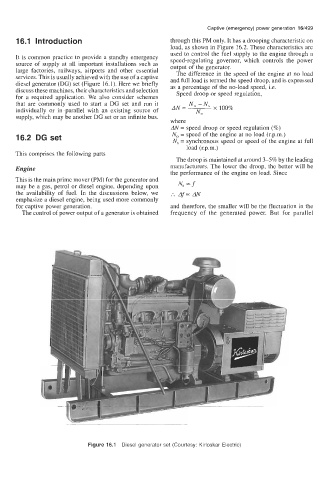Page 525 - Industrial Power Engineering and Applications Handbook
P. 525
Captive (emergency) power generation 16/499
16.1 Introduction through this PM only. It has a drooping characteristic on
load, as shown in Figure 16.2. These characteristics are
used to control the fuel supply to the engine through a
It is common practice to provide a standby emergency speed-regulating governor, which controls the power
source of supply at all important installations such as output of the generator.
large factories, railways, airports and other essential The difference in the speed of the engine at no load
services. This is usually achieved with the use of a captive
diesel generator (DG) set (Figure 16.1). Here we briefly and full load is termed the speed droop, and is expressed
as a percentage of the no-load speed, i.e.
discuss these machines, their characteristics and selection Speed droop or speed regulation,
for a required application. We also consider schemes
that are commonly used to start a DG set and run it
individually or insparallel with an existing source of AN= x 100%
supply, which may be another DG set or an infinite bus.
where
AN = speed droop or speed regulation (%)
16.2 DG set No = speed of the engine at no load (r.p.m.)
N, = synchronous speed or speed of the engine at full
load (r.p.m.)
This comprises the following parts
The droop is maintained at around 3-5% by the leading
Engine manufacturers. The lower the droop, the better will be
the performance of the engine on load. Since
This is the main prime mover (PM) for the generator and
may be a gas, petrol or diesel engine, depending upon Ns -f
the availability of fuel. In the discussions below, we Af-AN
emphasize a diesel engine, being used more commonly
for captive power generation. and therefore, the smaller will be the fluctuation in the
The control of power output of a generator is obtained frequency of the generated power. But for parallel
Figure 16.1 Diesel generator set (Courtesy: Kirloskar Electric)

